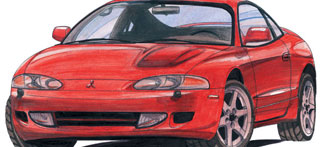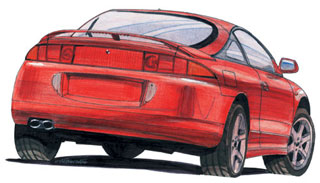Test drive Mitsubishi Eclipse 2000 - 2005 compartment
Mitsubishi Eclipse (1995-1999)
 Almost a real American car with Japanese roots is a second -generation Mitsubishi Eclipse.
Almost a real American car with Japanese roots is a second -generation Mitsubishi Eclipse. This car has an amazing fate - our buyer recognized him too late. At one time, official dealers tried to import Eclipse, but somehow it did not go. And now they are being taken to the country and bring second-hind. Not only from Vladivostok and from Kamchatka, but also from the States, although the American is much more expensive. The difference in price is explained by Russian eclites, it is associated not only with the left -handed steering wheel, but also with the fact that a law provides for criminal liability for twisting a mileage on the odometer is in force in the United States. Therefore, American cars are more honest than German. To our question why it is impossible to correct the odometer not in the zone of jurisdiction of state laws, but, say, in the garage in St. Petersburg, there was no intelligible answer. Apparently, stories about American eclips from the same series as the stories of Japanese Japanese, which are distinguished by special quality of the assembly.
Be that as it may, but in Russia to serve any car is not a problem - today Mitsubishi dealers have almost all spare parts. Although here, not without curiosity: the officers never had the front racks in warehouses, even in a short period of official sales. However, there is a market, as well as a fair amount of alternative spare parts for decent Japanese and European firms.
And not only Eclipse run around the expanses of our Motherland, but also his American clones under the Plymouth Laser and Eagle Talon names.
Shine and beggarly. The simplest basic version with front-wheel drive and a two-liter 140-horsepower atmospheric engine, similar to what was placed on Galant, is very popular among the friends of eclips. For ambitious macho, the combination is rather boring, but quite suitable for daily pathos movement around the city, moreover, very humane in cost. Men richerly prefer the GS-T version, also monotive, but with an engine with a capacity of 210 hp. by Lancer Evolution VI. This is a small rocket. However, the top of the model range and the dream of each acquired is the GSX (4G63) equipment: all-wheel drive, the same 210-horsepower engine with a turbine, increased brake discs, a more rigid front suspension and short springs.
The last car is on an advanced user, because the weakest place of the car is Viskoft, through which the moment is transmitted to the rear axle. There are plenty of lovers to raise a handbrake in a steep turn among Eclipse drivers, but the couplings cannot be carried out and fly. The new node can only be taken to order and at a price of $ 1000. At the disassembly, you can find about two times cheaper, but it will already be a lottery: it is not known how the owner of the late machine worked with the same handbrake.
When choosing a turbojection, special attention should be paid to the state of the body, more precisely, its geometry. The experience of the masters suggests that these cars rarely die with their death: their element is a route, an offsetting speedometer shooter, roaring music and, as a result, the rumble of crushed iron.
When studying the filling, maximum attention should be paid to the engine. Motor - from Evolution VI with a mitsubishi/Garret production turbine. The pressure pressure on the factory, and not on the modified version, is equal to one atmosphere (16 PSI). The turbine begins work with an intermediate cooler for about 1.5 thousand revolutions on the machine and 2.5 thousand - on a mechanical box. The cutting of revolutions works in the region of 8 thousand revolutions. We inform these data for those who want to save $ 100-200 on computer diagnostics. If the numbers correspond, then the car is rather alive than dead. If not, look for the usual signs of an imminent death of a turbocharger. They are known: stories of turbine oils and the knock of bearings at idle. We do not advise you to ignore them-together with the chic engine, Eclips inherited from the older brother, non-childish prices for spare parts of a connecting rod-piston group and bulkhead. On average, they start from $ 5-6 thousand for major repairs using original spare parts. Or from $ 9 thousand per jet engine with a small mileage from Japan. One comfort: a healthy motor is quite reliable and the consumables for it are cheap. For example, candles are a sore spot of all turbocharged cars-only $ 5.5 apiece and $ 25 for replacement work.
 Take care of the honor of a young man. The machine on Eclipse is put the same as on all Mitsubishi of those times, except that the control unit is different. It allows you to switch at different speeds depending on the position of the gas pedal, and also instantly throw it off the transmission below when pressing Overdrive. If this does not happen, the visit to the station will cost $ 200. If you just need to replace the oil and the filter, it is not so scary - $ 170. Serious repairs - here is how lucky, and the amount of expenses can approach $ 1.5 thousand.
Take care of the honor of a young man. The machine on Eclipse is put the same as on all Mitsubishi of those times, except that the control unit is different. It allows you to switch at different speeds depending on the position of the gas pedal, and also instantly throw it off the transmission below when pressing Overdrive. If this does not happen, the visit to the station will cost $ 200. If you just need to replace the oil and the filter, it is not so scary - $ 170. Serious repairs - here is how lucky, and the amount of expenses can approach $ 1.5 thousand. The steering by car - with hydraulic power and constant effort, regardless of speed - quite balanced for easy parking and successful maneuvering. Light knocks for maneuvers in place are tips ($ 75 apiece). The steering wheel itself is slightly large, but in fact it was not specially developed, but was simply taken from the Galant of the same model years. An alternative to him, say, Momo is $ 175.
Crowning to itself requires adhesion - burning it is easier. A characteristic smell in the cabin and slipping will remind you that it is time to prepare $ 250 (with work) for a new original or go broke by $ 700 for advanced cermets.
The car suspension, which received a special name Multi-Link, works perfectly when it is working. It is destroyed by her short moves, hard hangings and small rolls. Created on the basis of Lanserovskaya, it reluctantly digests the domestic road surface. Silent blocks are the first to die ($ 250 set), then racks (from $ 170) and levers (from $ 300).
Tusovka. Among the inveterate Japanese, Eclipse is considered a pathos and frivolous machine, suitable mainly for show -offs. However, around the car, not only a solid tuning infrastructure arose, but also a considerable club of fans and users of this brand. As in the case of any tuning, the costs of improvement are sometimes comparable to the cost of the source, and sometimes exceed them.
You can force yourself to respect in a party in the simplest way - to install several extraneous elements. The most affordable of them are K & N-n-n-n-ovic filter ($ 50) plus the back of the muffler bank, say, 5zigen ($ 200). The next step is the order of a typical body kit, both bumpers, thresholds and athery-anti-wing on the trunk lid are already more serious: about $ 2000 with the cost of painting and installation. The cast discs of inches on 19--20 with low-profile rubber will cost at least $ 3,000. And if you want to become your party in the board, then it would be nice to add cold inlet ($ 200 with work) to the nulevik, to the muffler bank - direct -flow output (from $ 700 with work). For a turbocharged version to the place will be a turbotimer (from $ 150), and a boost controller (from $ 250). Extremes can change the native of the Garret to a large one in the turbine and increase the boost pressure. In parallel, it is worth deleting the native bypass valve, fuel rail and nozzles. The spare parts HKS or Rally Art are great here. Prices for such work starts at $ 2000. If you wish, you can go even further - install the engine from the new tuned Lancer Evolution. But that is another story.
Text Denis Redardarchuk, drawing Dmitry Nazarov
Mitsubishi Eclipse 2.0 Turbo 2.0
Length/width/height (mm) 4375/1735/1290
Working volume (cubic cub) 1997 1997
Power (L.S.) 210 140
Full mass (kg) 1750 1750
Maximum speed (km/h) 220 203
Acceleration time 0-100 km/h (c) 7.8 9.4
Source: "Autopilot"






